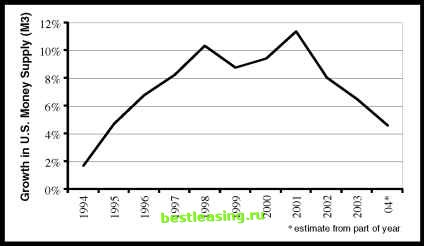

 |
 |

|
Промышленный лизинг
Методички
must be based on future decisions of the monetary authorities. Furthermore, the current chairman, Alan Greenspan, was born in 1926, so he might not even make it to the end of his current term in June 2008. Thus, all longer-term investments will be affected by the inflation rate determined with a new chair of the Federal Reserve. Consider the historical period between World War I and World War II. Between the wars, Germany experienced a hyperinflationary depression, while the United States had a deflationary depression. The German monetary authorities created huge amounts of money and destroyed the value of the German mark. The U.S. monetary authorities did not create inflation- quite the contrary, U.S. prices declined throughout the Great Depression. These extremely different outcomes suggest that the people in power determine the inflation rate. Although this may appear obvious, it is possible that the German authorities had no alternative. Similarly, some believe the current Japanese monetary authorities are powerless to prevent the current deflation. To the contrary, Milton Friedman believes that the Japanese can end deflation by simply increasing the money supply. I side with those who believe that the individuals in charge of monetary policy determine the inflation rate, constrained, but not controlled, by circumstances. Thus, a good prediction of inflation requires detailed understanding of the forces that will pull and push the people who determine inflation. Furthermore, as in high-level poker, inflationary predictions depend on the ability to predict human behavior. While it may be possible to predict the behavior of the next Federal Reserve chair, even before she or he is appointed, I have not seen a convincing prediction. Missouri on My Inflationary Mind Missouri is the show-me state, where residents are reported to wait for proof and not act on promises. When it comes to inflationary predictions, I suggest a show-me attitude. Rather than speculate on the future actions of monetary officials who have not yet been selected, a preferable financial strategy is: (i) based in the facts, and (ii) likely to perform well in either an inflationary or deflationary world. First, lets look at the monetary facts. Figure 5.3 depicts U.S. money supply growth over the last decade. Monetary growth has accelerated, so the facts provide some support for those who predict rising inflation. Monetary changes create inflation only after some time, and the Federal Reserve may have planted some seeds of inflation that will sprout in the years to come. Both gold prices and the value of the dollar confirm that inflation may be stirring. Gold has risen from $250 an ounce to over $400 an ounce. Over a similar period, the dollar has fallen significantly against many currencies and to an all-time low against the euro.17 These moves suggest that the Federal Reserves loose money policy is decreasing the value of the U.S. dollar. The inflationary case is not, however, complete. First, money supply growth over the last decade is still slower than the rates of increase in the 1970s. Second, money supply growth has slowed. So perhaps the Federal  FIGURE 5.3 Is the Federal Reserve Creating Inflation Again? Source: U.S. Federal Reserve Reserves policy is perfect. This optimistic view is that the Federal Reserve created lots of money to soften the effect of the bursting stock market bubble. Now that the economy may be emerging from that dour period, the Federal Reserve is easing up on money growth. If this optimistic scenario is correct, then inflation need not reappear. To repeat the mantra of this chapter as expressed by Milton Friedman, inflation is always and everywhere a monetary phenomenon. Thus, as long as we keep a clear eye on money growth, we should have early warning of any major change in inflation. If money growth increases, then inflation will follow and investments should be in tangible assets including gold and land, and in currencies other than the U.S. dollar. If deflation becomes likely because of slow monetary growth, then financial assets, particularly certain bonds, should do well. For example, the simple U.S. Treasury bond, even with a yield of just 5% per year, could be extremely profitable in a deflationary environment. Buy Your Inflation Insurance at Irrationally Low Prices In addition to looking out for changes in the money supply, there are a number of financial steps that make sense in any environment. Recall from our discussion of human nature that our lizard brains tend to put too much weight on recent experience. Since Paul Volcker stopped inflation in 1979, the United States has experienced nearly perfect inflation rates. This suggests that most investors will be too little concerned with the possibility of either inflation or deflation. Having spent 20 years in a Goldilocks zone of low and stable inflation rates, we are likely to overlook the possibility of problems. A funny thing happens to the stock of insurance companies after disasters. When a hurricane, fire, or earthquake hits, the insurance companies pay claims that can add up to billions of dollars. What do you think happens to the stock price of these companies immediately after disaster 1 2 3 4 5 6 7 8 9 10 11 12 13 14 15 16 17 18 19 20 21 22 23 24 25 26 27 28 29 30 31 32 33 34 35 36 [ 37 ] 38 39 40 41 42 43 44 45 46 47 48 49 50 51 52 53 54 55 56 57 58 59 60 61 62 63 64 65 66 67 68 69 70 71 72 73 74 75 76 77 78 79 80 81 82 83 84 85 86 87 88 89 90 91 92 93 94 95 96 97 98 99 100 101 102 103 104 105 |